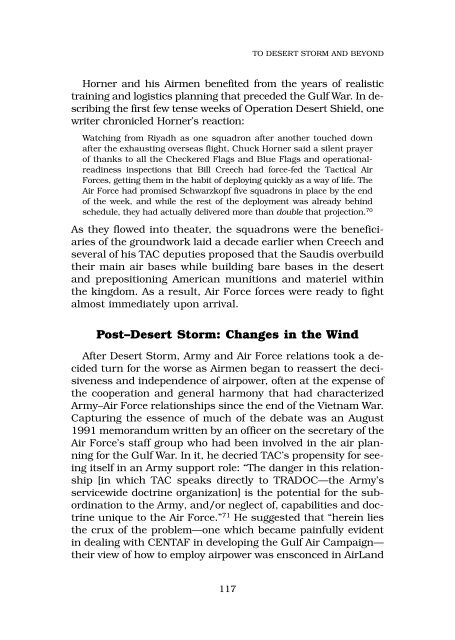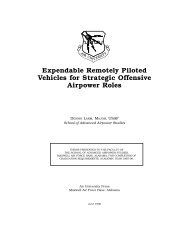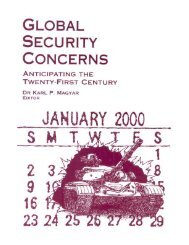Making of Bill Creech - Project Gutenberg Consortia Center
Making of Bill Creech - Project Gutenberg Consortia Center
Making of Bill Creech - Project Gutenberg Consortia Center
Create successful ePaper yourself
Turn your PDF publications into a flip-book with our unique Google optimized e-Paper software.
TO DESERT STORM AND BEYONDHorner and his Airmen benefited from the years <strong>of</strong> realistictraining and logistics planning that preceded the Gulf War. In describingthe first few tense weeks <strong>of</strong> Operation Desert Shield, onewriter chronicled Horner’s reaction:Watching from Riyadh as one squadron after another touched downafter the exhausting overseas flight, Chuck Horner said a silent prayer<strong>of</strong> thanks to all the Checkered Flags and Blue Flags and operationalreadinessinspections that <strong>Bill</strong> <strong>Creech</strong> had force-fed the Tactical AirForces, getting them in the habit <strong>of</strong> deploying quickly as a way <strong>of</strong> life. TheAir Force had promised Schwarzkopf five squadrons in place by the end<strong>of</strong> the week, and while the rest <strong>of</strong> the deployment was already behindschedule, they had actually delivered more than double that projection. 70As they flowed into theater, the squadrons were the beneficiaries<strong>of</strong> the groundwork laid a decade earlier when <strong>Creech</strong> andseveral <strong>of</strong> his TAC deputies proposed that the Saudis overbuildtheir main air bases while building bare bases in the desertand prepositioning American munitions and materiel withinthe kingdom. As a result, Air Force forces were ready to fightalmost immediately upon arrival.Post–Desert Storm: Changes in the WindAfter Desert Storm, Army and Air Force relations took a decidedturn for the worse as Airmen began to reassert the decisivenessand independence <strong>of</strong> airpower, <strong>of</strong>ten at the expense <strong>of</strong>the cooperation and general harmony that had characterizedArmy–Air Force relationships since the end <strong>of</strong> the Vietnam War.Capturing the essence <strong>of</strong> much <strong>of</strong> the debate was an August1991 memorandum written by an <strong>of</strong>ficer on the secretary <strong>of</strong> theAir Force’s staff group who had been involved in the air planningfor the Gulf War. In it, he decried TAC’s propensity for seeingitself in an Army support role: “The danger in this relationship[in which TAC speaks directly to TRADOC—the Army’sservicewide doctrine organization] is the potential for the subordinationto the Army, and/or neglect <strong>of</strong>, capabilities and doctrineunique to the Air Force.” 71 He suggested that “herein liesthe crux <strong>of</strong> the problem—one which became painfully evidentin dealing with CENTAF in developing the Gulf Air Campaign—their view <strong>of</strong> how to employ airpower was ensconced in AirLand117






